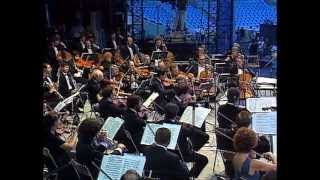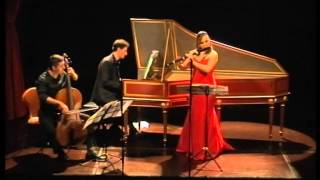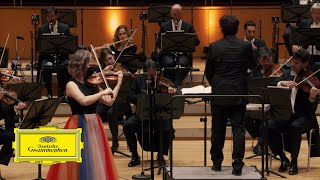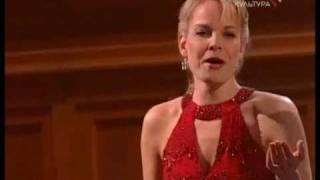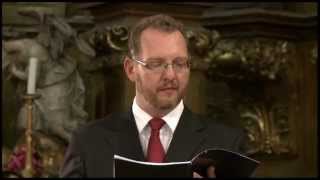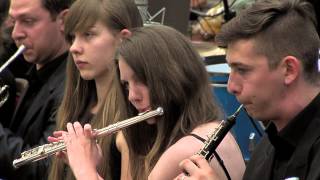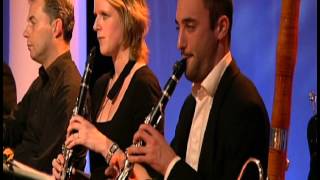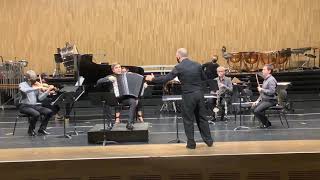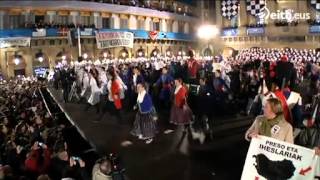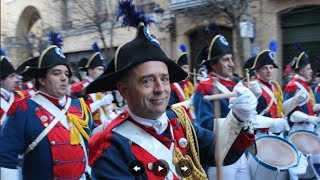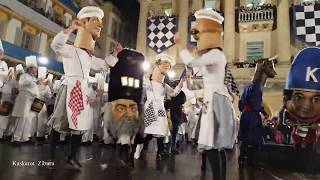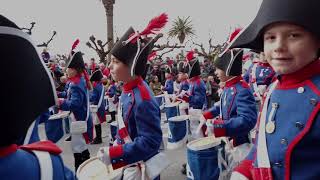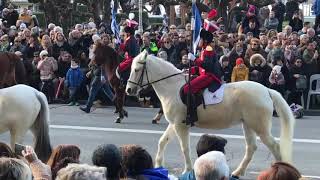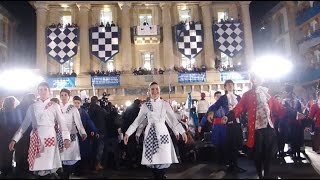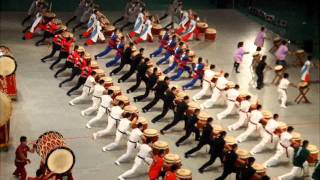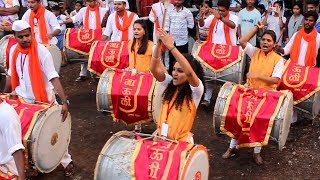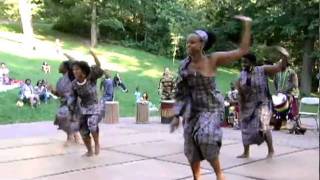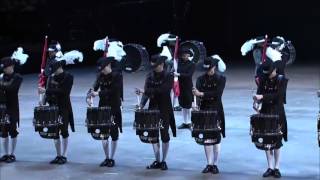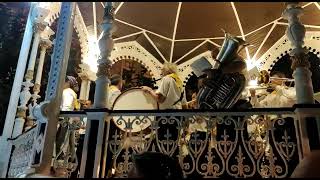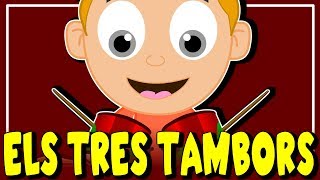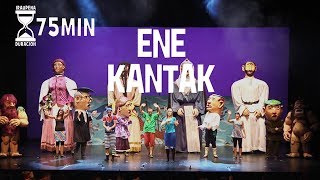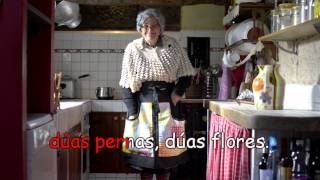At 0:00 on January 20th, the Donostiarra Tamborrada Festival begins
Recommended music videos for initiation to classical music
The San Sebastian drum parade is the festival with which every January 20 the city of San Sebastian celebrates the day of San Sebastian , its patron saint. The Tamborrada festival consists of a series of parades of drummers and replicants playing pieces, most of which were composed specifically for the event by Raimundo Sarriegui in the 19th century . Those carrying drums are dressed in Napoleonic military uniforms, while the replicants, who carry wooden barrels, are dressed as cooks.
Raimundo Sarriegi (1813-1913) was a musician from San Sebastián, author of works for choir, for txistu, and some zarzuela; but above all, he was the author of most of the compositions for the Tamborrada of San Sebastián . He was born in a farmhouse (called "Etxeberri" or "Kojaenea") in the Egia neighbourhood of San Sebastián/Donostia , at the end of the First Carlist War, to a family of farmers. From a young age he was involved in music; he began as a soprano in the Church of Santa María and later became a recognised tenor in the Parish of San Vicente . He was a disciple of the maestro José Juan Santesteban el "maixua" and his favourite student.
March of San Sebastian . With the raising of the flag and the interpretation of the March of San Sebastian by Sarriegui, the Semana Grande of San Sebastian begins at 0:00 hours on January 20, which will end at 24:00 hours. In this video we offer it in a version by the Orfeón Donostiarra accompanied by the Euskadi Symphony , under the direction of maestro Víctor Pablo Pérez .
Joseph Bodin de Boismortier (1689 – 1755) was a French Baroque composer who wrote both instrumental and vocal works, cantatas and ballets. Boismortier 's family moved from the composer's birthplace of Thionville in Lorraine to the city of Metz where he received his education. In 1713 he travelled to Perpignan , where he married Mara Valette ; in 1724 they moved to Paris where Boismortier began his prolific career as a composer. By 1747 he had published over 100 works for different combinations of voice and instruments. Boismortier was one of the first composers not to be dependent on a patron or protector, composing music of great beauty and sophistication that was greatly appreciated by the French public.
Catalogue of Boismortier's works . His works are classified by their Opus number (from the Latin opus 'work'; op. abbreviation) which is a term used in music to catalogue the works of most composers since the 17th century .
Today we offer the Sonata in E Minor op. 37, no. 2 written by Joseph Bodin de Boismortier and performed on this occasion by Nihan Atalay (flute), Ciprian Campean (cello) and Corsi Paolo (harpsichord); sonata articulated in three movements: I (0´6´´) ALLEGRO .-. II (2´34´´) ADAGIO .-. III (4´42´´) ALLEGRO
Antonín Dvořák (1841-1904) was born in Nelahozeves , then Bohemia , now Czech Republic , and is regarded as one of the great masters of the second half of the 19th century and a leading exponent of Czech nationalism. From 1892 to 1895, Dvořák was director of the National Conservatory in New York ; from his arrival in the USA he showed a great interest in Native American music. In April 1895 he left the United States and returned permanently to his homeland, where he resumed his work as a teacher at the Conservatory. Throughout his life he wrote music for piano, for violin and piano, trios, quartets, quintets, a sextet, two series of Slavonic dances, serenades, suites, overtures, three rhapsodies, five symphonic poems, nine symphonies (the New World symphony being the best known), several concertos, 100 songs and vocal duets, and several operas.
The Violin Concerto in A minor, Op. 53 is a concerto for violin and orchestra, composed by Antonín Dvořák in 1879. After several revisions, the work was premiered in Prague in 1883 with violinist František Ondrícek , who also played it in London and Vienna . The concerto is written for solo violin and an orchestra consisting of 2 flutes, 2 oboes, 2 clarinets (in A ), 2 bassoons, 4 horns, 2 trumpets, timpani and strings, and its structure is the classical three-movement (fast-slow-fast). This concerto today remains an important work in the universal violin repertoire.
In this video, the American violinist Hilary Hahn ( Virginia, 1979) offers us the third of the movements, Finale: Allegro giocoso ma non troppo , accompanied by the Frankfurt Radio Symphony Orchestra conducted by the Colombian maestro Andrés Orozco-Estrada .
Francisco Asenjo Barbieri (1823-1894) was a Spanish composer born in Madrid who, after entering the Madrid Conservatory, studied piano, clarinet, singing and composition, managing to write, throughout his career, more than 70 zarzuelas. Founder of the magazine La España Musical , he staunchly defended the ideas of musical theatre in Spanish, which ultimately led to the resurgence of the zarzuela . He was a member of the Academy of Fine Arts and the Royal Spanish Academy .
El Barberillo de Lavapiés is a zarzuela in three acts with a libretto by Luis Mariano de Larra and music by maestro Barbieri . It premiered with great success at the Teatro de la Zarzuela on December 19, 1874 and tells us the entertaining adventures of Lamparilla , a barber from Lavapiés , and the seamstress Paloma , who find themselves immersed in a world of political intrigue within the traditional atmosphere of Madrid under Charles III . Today we are attending the ballad of the Song of Paloma .
Elīna Garanča (1976) is a mezzo-soprano born in Riga , Latvia , daughter of a professional singer and a choir director. At the age of twenty she began studying singing at the Latvian Academy of Music and continued her studies in Vienna and the USA . She began to stand out internationally at the Salzburg Festival with Mozart 's opera La Clemenza di Tito , after which she received important contracts. She has worked in the most important theatres in the world under the most eminent conductors. In addition to her refined technique, it is worth highlighting the homogeneity in the different heights of her tessitura, virtues that lead her to be among the most appreciated mezzos of today.
Recommended classical music videos
Johann Sebastian Bach (1685-1750) Today we meet one of the three giants of Western music along with Mozart and Beethoven . He was a German violinist, organist, conductor and composer, born in Eisenach into the most prominent musical family in history. In 1703 he obtained his first job in Arndstat and in 1707 he moved to Mülhausen as an organist, where he married his cousin Maria Barbara with whom he had seven children. In 1708 he left Mülhausen to work as concertmaster and organist at the Duke of Weimar 's chapel where he composed numerous keyboard and orchestral works while also having the opportunity to transcribe and study various works by Vivaldi . After the death of his wife in 1720, after a year and a half of widowhood, he married Maria Magdalena again with whom he would have another thirteen children. In 1723 he moved to Leipzig where he would reside until his death at the age of 65. His influence has been notable on Haydn , Mozart , Beethoven , Mendelssohn , Schumann , Chopin … and many other renowned composers.
The catalogue of Bach's works or Bach-Werke-Verzeichnis , better known by its initials BWV , consists of a numbered index of all the composer's works arranged thematically by type of work or genre and according to their vocal or instrumental nature and used by scholars and musicians around the world. This catalogue was created in 1950 by the German musicologist Wolfgang Schmieder .
Cantata Ich hatte viel Bekümmernis BWV 21. The Italian influence was immediately noticeable in Bach ’s music during his stay in Weimar . Clear echoes of one of Vivaldi ’s concertos can be heard in the opening chorus of this cantata, “Ich hatte viel Bekümmernis”. An early version of the cantata probably originated in 1713, written for the funeral of the wife of a high court official on 8 October. The sermon theme for this service was Psalm 94, verse 19 , which is precisely the text of the opening chorus of Bach ’s cantata.
Structure . 0:00 Symphony .-. 3:08 Ich hatte viel Bekümmernis (Chorus) .-. 7:13 Seufzer, Tränen (Aria).-. 11:55 Wie hast du dich (Recitative).-. 13:28 Bäche von gesalznen Zähren (Aria) .-. 18:38 Was betrübst du dich (Chorus).-. 22:17 Ach Jesu, meine Ruh (Recitative).-. 23:46 Komm, mein Jesu (Duet) .-. 27:58 Sei nun wieder zufrieden (Chorus) .-. 32:42 Erfreue dich, Seele (Aria).-. 35:39 Das Lamm, das erwürget ist (Chor)
The performance is by the Netherlands Bach Society , Shunske Sato (violin and conductor), Ivan Podyomov (oboe), Stefanie True (soprano), Ulrike Malotta (alto), Guy Cutting (tenor), Felix Schwandtke (bass). (Notes taken from the commentary at the bottom of the video)
Franz Schubert (1797-1828) Austrian composer who at the age of 11 was admitted as a member of the choir of the Imperial Chapel in Vienna where he had Salieri as his teacher. At that time, what brought in money was theatre and opera, a genre in which he never managed to excel; so he turned to lieder (songs), among which his Ave Maria stands out. and the lieder collection La Bella Molinera . Despite dying at the age of 31, he left behind more than 1,500 written works, including numerous piano and chamber music pieces, 8 symphonies, concertante works, incidental music, sacred music (among others, 7 Masses, 1 Oratorio and 1 Requiem), several singspiel (small operettas), some opera and more than 600 short vocal works, mainly the lieder mentioned above.
Franz Schubert's Symphony No. 8 in B minor, D. 759 (sometimes renumbered Symphony No. 7), commonly known as the Incomplete Symphony , is a musical composition that Schubert began in 1822 but which, although the composer lived for another six years, he finished with only two movements: I (0´35´´) ALLEGRO MODERADO .-. II (17´01´´) ANDANTE CON MOTO. A scherzo also survives, almost completed in a piano reduction but with only two orchestrated pages. One possible reason why Schubert left the symphony unfinished is the predominance of the same metre (ternary meter); this is the case in the first and second movements, as well as in the aforementioned scherzo, which could be the germ of the third movement.
Today we attend the version offered by the Polish teacher Małgorzata Sapiecha-Muzioł .
The Six ("Les Six") were a French group of musicians from the early first half of the 20th century composed of: Georges Auric, Louis Durey, Arthur Honegger, Darius Milhaud, Francis Poulenc, Germaine Tailleferre (the only woman in the group), Jean Cocteau (the only one who was not a musician, but was the artistic representative), Erik Satie (who would leave the group in 1918). The group that Erik Satie christened "The New Young People" ("Les Nouveaux Jeunes") met for the first time in the painter Lejeune 's studio in Montparnasse , with a program that was summarized in a single objective also formulated by Satie : "These societies, the National, the SMI, play the music of others; we will make a society to play our music." Their music fundamentally rebelled against Impressionism and Wagnerism ; and although they wrote some works collectively, each one derived in his own, personal style. After numerous disagreements, they did not see each other again after 1930, refusing to give explanations.
Darius Milhaud (1892–1974) was a French composer known for his use of polytonality and rhythmic patterns derived from jazz . In 1916 he travelled to Brazil as secretary to Paul Claudel , then ambassador; there he wrote Saudades do Brasil , Scaramouche , Le Bœuf sur le toit and the choreographic poem L'Homme et son desir . In 1918 he returned to France , befriended Erik Satie and became a member of the group Les Seis . In 1940 he fled the occupation of France by the Nazis and moved to the USA , where he remained until 1947 when he returned to France to work as an honorary professor of composition at the Paris Conservatoire . He wrote more than 400 works in all kinds of musical genres from chamber music to choral works, symphonies, operas and incidental music.
Concerto for Percussion and Small Orchestra is one of the earliest concertos written for a percussion soloist, and is one of the most frequently performed pieces in the repertoire; it was written in Paris for percussion and a small orchestra. Being written in the 1920s, this piece saw the light of day at the height of jazz music; however, Milhaud intended not to include jazz ideologies in his music; in this work he countered the jazz style by composing it in a polytonal form. The percussion ideas used in this piece are not composed with a solo approach; rather, the entire percussion section is played by a single person.
Structure . The work consists of two movements: I VIF, RUDE ET DRAMATIQUE (0´21´´) A hard and dramatic movement based on polytonal harmonies. II MODÉRÉ (3´09´´) A lyrical movement, contrasting with the previous one and featuring short solos on different instruments interrupted in the final section by brief reminders of the initial theme.
As a soloist, we are joined today by master percussionist Laura Trompetter . (Excerpts from Elizabeth Kosko's article, 2010)
The accordion is a wind musical instrument, consisting of a bellows, a fingerboard and two wooden sound boxes. The bellows are closed at both ends by wooden boxes. The right-hand side of the accordion also has a fingerboard with an arrangement of keys that can be like a piano ( piano accordion ) or round keys (also called buttons ); the left-hand side has buttons on both types of accordion to play the bass and accompaniment chords.
Francisco Domínguez was born in Alcolea de Calatrava (Ciudad Real). He studied composition with Gabriel Erkoreka at Musikene , the Higher Music Centre of the Basque Country , where he graduated with honours. He subsequently continued his studies in Austria and Germany .
Iñaki Alberdi is an accordionist from Guipuzcoa who has collaborated closely with various contemporary composers and has premiered works by Sofia Gubaidulina, Karlheinz Stockhausen, Luis de Pablo, Joan Guinjoan, Gabriel Erkoreka, Ramon Lazkano, Jesús Torres, Alberto Posadas and José María Sánchez-Verdú . As a soloist, he is a regular guest with orchestras such as the Royal Liverpool Philharmonic, the National Orchestra of Spain, the RTVE Symphony Orchestra, the Royal Philharmonic of Galicia, the Orchestra of the Community of Madrid, the Bilbao Symphony Orchestra, the Montevideo Philharmonic Orchestra, the Euskadi Symphony Orchestra and the Orchestra of the Ministry of Culture of Russia , among others. He has been nominated for the Gramophone Editor's Choice Award and has won the Outstanding Scherzo Record and the Golden Melómano . (Extracted from Contrapunto magazine).
Today we present La Noche by Francisco Domínguez, written for accordion and mixed ensemble, accompanied by the Ensemble Kuraia under the baton of Andrea Cazzaniga
Drums of Donostia
Origins of the Tamborrada. In 1597 there was a plague epidemic in Pasajes , then a district of San Sebastián ; the neighbours went to the Church of San Sebastián to say their prayers to him, after which the epidemic disappeared; so the neighbours took him as Patron of the city promising to celebrate his date. The Tamborrada was at first a prelude to Carnival , since already in 1835 a carnival troupe, in which everyone dressed up as they pleased, went out at around five in the morning on the 20th as a reveille; it was for this troupe that Sarriegi composed his tamborrada works that he would expand for other Carnival troupes. In 1881 the City Council donated some drums and some Napoleonic uniforms that were kept in the San Telmo Barracks ; Five years later, the barrels were added, which came to symbolise the city's residents. The number of companies gradually increased until reaching 16 in 1976 and 143 in 2018. In addition, in 1927 the Children's Drum Parade paraded for the first time, which today brings together more than 5,000 children.
Drums of the world
The drum is a percussion instrument of indeterminate sound, belonging to the family of membranophones (the vibration of the instrument is obtained in a membrane made of skin or synthetic materials). It consists of a resonance box, which is usually cylindrical in shape, and a membrane called a patch, which covers the opening of the box. Some types of drums have patches on both sides and the sound is usually obtained by hitting the instrument on the patch with the hand or with drumsticks. On the other hand, and especially in colloquial language, the word drum is also applied to other percussion instruments that are not membranophones but idiophones (the sound is obtained by the vibration of the instrumental body itself); in the case of the Tamborrada donostiarra , the wooden barrels of the replicants. From this it is deduced that, for it to be considered a drum, the fact of percussion is more decisive than the fact that it has vibrating membranes.
Recommended music videos for children
Various Wikipedia articles have been used to write these texts.
The texts of Videomusicalis are written in Basque, Spanish and English.





